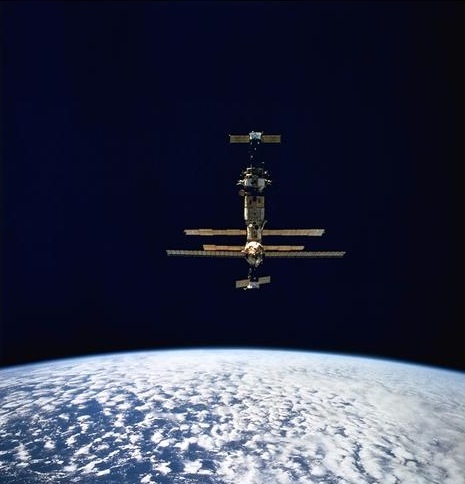by Mikhail Chernyshov, Space Writer, Novosti Press Agency
SPACE TODAY was founded as a print newsmagazine in 1986. It migrated to online publication in 1995 as SPACE TODAY ONLINE (STO).
As the crown jewel of the space program of the Union of Soviet Socialist Republics (USSR), the third-generation Mir station floated in orbit above Earth for fifteen years from 1986 to 2001. In 1987, cosmonauts from the Soviet Union took up permanent occupancy in the orbiting station. Over the years, cosmonauts took many spacewalks outside Mir.
This STO print archive article is a special report on an October 1988 spacewalk by cosmonauts at the orbiting Mir space station, written in 1989 by Mikhail Chernyshov, space writer, Novosti Press Agency, in response to a request for information from the editors of Space Today.
Novosti dates to 1941 when the Soviet Information Bureau (Sovinformburo) was established by the Central Committee of the Russian Communist Party. Today, long after the breakup of the Soviet Union, Russian Information Agency - Novosti is the state news and analytical agency of the Russian Federation publishing periodicals and offering press and photo services.
 Mir station while still in orbit |
"The spacewalk pursued several aims," Victor Blagov, deputy flight director said. "The first two were to test new spacesuits and to complete repairs on the Dutch TTM telescope on the external wall of the Kvant-1 astrophysical module, which forms part of the orbital complex.
"Additional operations were also planned: to assemble an aerial for radio communication with amateurs, to mount a special anchor for a Soviet-French crew that plans a spacewalk late in December of this year, and to remove dust from portholes and a TV camera on the Kvant-1's outer wall."
Broken Lens. As for the spacesuits, their tests were planned in advance, before the start of the space expedition last December. However, it so happened later that the lens of the Kvant-1 telescope -- a block of electronic detectors -- deteriorated and had to be repaired. The repairs were begun last June but were not finished because the key for unlocking the block ring was broken. Replacement of the lens was postponed. Now it was decided to combine the two tasks during one spacewalk. If everything went smoothly and the cosmonauts had time to spare, they would perform other jobs.
"The key, broken when unlocking the fastening ring, developed into quite a problem," according to Oleg Tsygankov, a space repairs specialist.
"We had to devise three methods of separating or breaking up the ring embedded in the telescope's tube. A set of seven tools -- including an abrasive electric cutter, drills, removers and special nippers -- were developed.
Quick Job. "In fact, about three-quarters of the work to get to the ring was already done by the cosmonauts during their previous spacewalk in June. If everything were to go smoothly, Titov and Manarov would only need ten minutes to open the ring and install a new detector block.
"The rest of the time could be spent on erecting an amateur radio aerial, on cleaning up the portholes and TV camera lens, and on installing an anchor. The anchor saved the coming Soviet and French cosmonauts some 30 minutes during their spacewalk December 9, 1988, for testing solar panels mounted on an intricate structure which opens up only in space."
"As for the spacesuits," says Mikhail Balashov, one of the suit's developers, "the cosmonauts first tested them in the station, working on the exact copies of the fastening ring sent by the Dutch. The new spacesuits do not differ from the old ones in outward appearance. It is the sleeves that have been modified mostly. They now can be adjusted for height and size.
Changing Sleeves. "Normally, one spacesuit is used many times. The leg and arm sleeves, being most vulnerable, are sometimes damaged," Balashov explained. "It is understandable that to glue together or sew up a torn sleeve on board the spacecraft is not the best way of repairing them. Sleeves of the new spacesuit -- whether for legs or arms -- can be replaced totally.
"Some modifications have been made in other parts of the suit. The gloves now are more flexible. Life-support systems last longer," Balashov said.
A spacesuit for extravehicular activities does not look too complex -- but that is so only at first sight. Experts once counted that a spacesuit contains more elements and systems than a car.
Miniature Spacecraft. Indeed, it has the heat regulation system, a medical monitoring block, and radio communications facilities...to name a few. In fact, a spacesuit is a real spacecraft in miniature.
Experts stress that the new spacesuit has its own power sources and can operate independent of the station. True, the lifeline remains, for there are no means at the Mir orbital station as yet to get back a cosmonaut who has broken free. Oxygen supplies in the main and standby cylinders make up, all in all, 1,500 liters. This allows a cosmonaut to work in open space for up to eight and a half hours -- but that is the limit. That time includes all preparatory operations so actual time in space doing most work rarely exceeds six hours.
For the October spacewalk, it was early morning when the Mir crew began final preparations for their job outside. At 10 a.m., Titov and Manarov opened the outer hatch and emerged from the station. Difficulties began at once...first with the umbilical cord which got tangled. But, somehow, the cosmonauts coped with all problems as they arose. In the end, the planned operations were completed an hour ahead of schedule.
Learn more about the former Soviet Union in space: